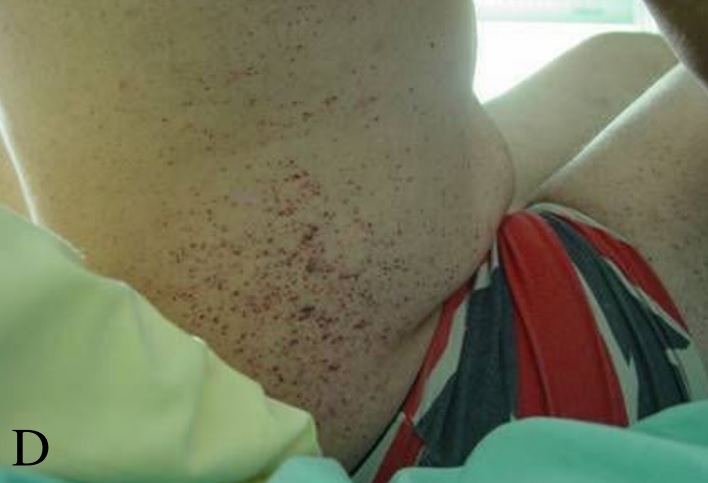Fabry Disease

| |
| Fabry Disease | |
|---|---|
| Inheritance | X-linked |
| Genetics | GLA pathogenic variant |
Fabry disease, the most prevalent lysosomal storage disorder, is an X-linked genetic disease that causes deficiency in the alpha-galactosidase A (α-Gal A) enzyme. This results in the progressive accumulation of glycolipids (globotriaosylceramide and related compounds) in various tissues and organs. Severe episodic pain crises in the extremities is one of the manifestations of the disease. Depending on enzyme activity the disease can manifest as a child (classic phenotype) or later on even as an adult (atypical and late onset variants). Enzyme replacement therapy is available.[1]
Genetics
Fabry disease is characterized by an X-linked inheritance pattern. Hemizygous males are affected, while females with heterozygous genotypes can exhibit a wide range of symptoms, from being asymptomatic to displaying signs as severe as affected males (manifesting heterozygote). In cases where multiple individuals within a family are affected, the affected male's mother is an obligate heterozygote. If a family has only one male member affected by Fabry disease, it is likely that his mother carries the heterozygous GLA pathogenic variant. However, in rare instances, a de novo pathogenic variant may be present in a single affected male within a family. A female with a heterozygous genotype has a 50% chance of transmitting the GLA pathogenic variant during each pregnancy. An affected male will pass on the pathogenic variant to all his daughters, but none of his sons.
Clinical Features
Males with the classic form, who have less than 1% α-Gal A enzyme activity, typically experience symptoms onset during childhood or adolescence. These symptoms include severe pain crises in the limbs (acroparesthesia), vascular skin lesions (angiokeratomas - the most visible early clinical feature), abnormalities in sweating (anhidrosis, hypohidrosis, or rarely hyperhidrosis), distinctive corneal and lenticular opacities, and proteinuria. Kidney function gradually deteriorates, leading to end-stage renal disease (ESRD) in men between their third and fifth decades. Cardiac and/or cerebrovascular diseases often develop in middle-aged men who have been successfully treated for ESRD, contributing to significant morbidity and mortality. Heterozygous females usually exhibit milder symptoms with a later onset compared to males, and in rare cases may be asymptomatic throughout their lives or experience symptoms as severe as males with the classic form.
Males with late-onset forms, who have greater than 1% α-Gal A activity, present with clinical manifestations like cardiac disease (including left ventricular hypertrophy, cardiomyopathy, arrhythmia, and proteinuria), renal failure associated with ESRD but without skin lesions or pain, or cerebrovascular disease manifesting as stroke or transient ischemic attack.
| Feature | Classic | Late-Onset Variants | |
|---|---|---|---|
| Age at onset | 4-8 yrs | >25 yrs | |
| Average age of death | 41 yrs | >60 yrs | |
| Manifestation | Angiokeratoma | ++ | – |
| Acroparesthesia | ++ | –/+ | |
| Hypohidrosis/anhidrosis | ++ | –/+ | |
| Corneal/lenticular opacity | + | – | |
| Cardiac disease | LVH/ischemia | LVH/cardiomyopathy | |
| Cerebrovascular disease | TIA/stroke | – | |
| Renal disease | ESRD | Proteinuria or ESRD | |
| Residual α-Gal A enzyme activity | <1% | >1% | |
Diagnosis
The most efficient and reliable method to diagnose Fabry disease in males is by identifying deficient α-Gal A enzyme activity in plasma, isolated leukocytes, or cultured cells. Confirmation of the diagnosis in a male proband is achieved through molecular genetic testing to identify a hemizygous GLA pathogenic variant. In heterozygous females, the diagnosis is established by identifying a heterozygous GLA pathogenic variant through molecular genetic testing.
Management and Treatment
Treatment of Manifestations
- Pain reduction (acroparesthesia): Diphenylhydantoin, carbamazepine, or gabapentin
- Cardiac ischemia: Aspirin, lipid-lowering agents, and blood pressure control
- Stroke prophylaxis: Aspirin and/or other antiplatelet agents
- Proteinuria reduction: ACE inhibitors or angiotensin receptor blockers
- ESRD: Chronic hemodialysis and/or renal transplantation
- Auditory and vestibular symptoms: Rehabilitation and hearing aids
- Psychiatric manifestations: Management per psychologist/psychiatrist
Prevention of Primary Complications
Enzyme replacement therapy (ERT), with or without chaperone therapy (e.g., migalastat), is recommended as early as possible for all males with Fabry disease, including children and those with ESRD undergoing dialysis and renal transplantation, and females with clinical disease manifestations. ERT aims to prevent and/or delay the progression of renal, cardiac, and cerebrovascular manifestations.
Surveillance
Annual assessments are recommended for angiokeratomas, acroparesthesia, sweating abnormalities, and gastrointestinal, pulmonary, and vascular manifestations. Cardiology assessments should be conducted annually in males from age 18 and biannually in females from age 18. Neurological assessments should begin at age 18, with brain MRI/MRA every two to three years. Renal function, audiology evaluations, and psychological assessments should be performed annually, or more frequently as needed.
Agents and Circumstances to Avoid
Individuals with Fabry disease should avoid smoking. The effects of amiodarone on individuals with Fabry disease remain inconclusive, as evidence is insufficient to determine whether it is detrimental or not.
Evaluation of Relatives at Risk
Early identification of affected male and female relatives is essential to initiate appropriate management as early as possible. Molecular genetic testing (if the family's GLA pathogenic variant is known) or measurement of α-Gal A enzyme activity in males only (if the family's GLA pathogenic variant is unknown) can be used for early identification.
Resources
References
Literature Review
- Reviews from the last 7 years: review articles, free review articles, systematic reviews, meta-analyses, NCBI Bookshelf
- Articles from all years: PubMed search, Google Scholar search.
- TRIP Database: clinical publications about evidence-based medicine.
- Other Wikis: Radiopaedia, Wikipedia Search, Wikipedia I Feel Lucky, Orthobullets,


